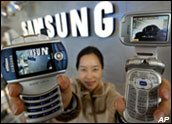
Qualcomm today announced it would conduct a live demonstration of its mobile TV FLO Technology withSamsung Electronics at the 2006 International Consumer Electronics Show taking place in Las Vegas this week.
FLO Technology, a multicast innovation and key component of Qualcomm’s MediaFLO System, is an air-interface system designed to increase capacity and coverage, while reducing the cost of delivering multimedia content to mobile handsets.
The demonstration will feature over-the-air delivery and viewing of multiple channels of wireless multimedia content, both streaming video and multicast packet data.
Incorporating FLO technology with Samsung handsets will help to bring advanced wireless multimedia services to customers around the world, according to Rob Chandhok, vice president of engineering and market development for Qualcomm MediaFLO Technologies.
“Feature-rich handsets that support high-quality video and deliver superior sound are critical in any solution that promises to deliver an optimum mobile video service to wireless subscribers,” he said.
In the Flo
Engineered specifically for the mobile environment, FLO Technology offers several advantages over other OFDM-based mobile multicast technologies, Qualcomm said.
Those advantages include higher-quality video and audio, faster channel-switching time, superior mobile reception, optimized power consumption and greater capacity compared to other multicast technologies, according to the company.
FLO Technology supports up to 20 streaming channels of high-quality video at up to 30 frames per second, 10 stereo audio channels, and up to 800 minutes of stored Clipcast content per day. Qualcomm said the average channel-switching time is 1.5 seconds without buffering or progress bars.
Opening Up Opportunities
FLO also reduces the network cost of delivering multimedia content by dramatically decreasing the number of transmitters that need to be deployed, according to Qualcomm.
In addition, the company said FLO Technology-based multimedia multicasting will complement wireless operators’ cellular network data and voice services, delivering content to the same handsets used on their 3G networks.
With demand for mobile multimedia services rising among wireless consumers, FLO mobile video technology could open up new opportunities for Samsung, said Hunbae Kim, vice president of the company’s mobile research and development team.
“By combining Samsung’s world-class wireless phone design and technology with MediaFLO’s simple and intuitive end-to-end system, we’re creating a compelling multimedia solution and consumer experience,” Kim said.
A Big Year for Mobile Video
The year 2006 is going to be big for mobile video — including short clips, pre-recorded TV shows and live broadcasts — Jupiter Research Analyst Michael Gartenberg told TechNewsWorld.
“You need the infrastructure to make it all happen. Qualcomm is providing some important technology for its partners to deploy,” he said. “Look to see a lot of different mobile video solutions, approaches and devices this year — from more generic handsets to sophisticated smartphones to devices with PDA-like functionality.”
That said, is there genuine consumer demand for mobile video? Or is it being pushed from the top down?
Consumer interest is stronger than many might think, Gartenberg said. Combined with fast wireless networks, technologies like FLO are a win for consumers, he noted.
Waiting for the Promise
Qualcomm expects to begin commercial operation of the MediaFLO System in the fourth quarter of 2006.
FLO Technology is supported by the FLO Forum, an organization responsible for driving the global standardization of the technology.
More than 25 leading wireless industry companies from around the world have joined together through the FLO Forum. Their goal is to ensure that FLO Technology specifications will be open and available to a wide range of technology providers, as well as equipment and handset manufacturers.





















































